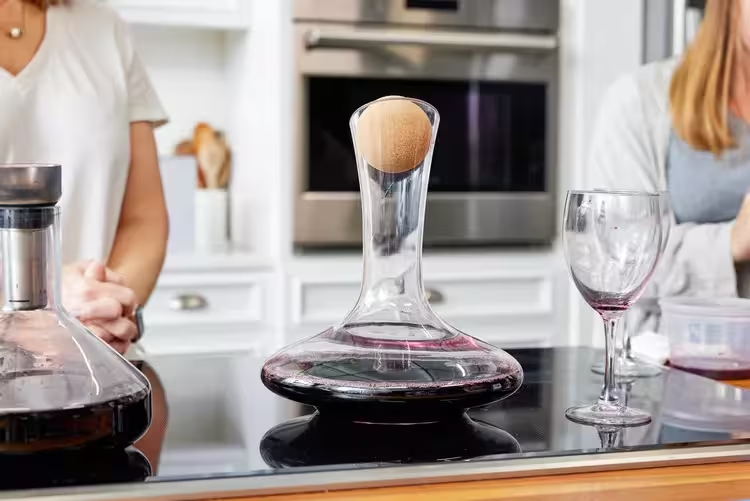

How Wine Decanters Work: Unlocking the Full Potential of Your Wine
Wine enthusiasts often describe the joy of experiencing a glass of wine as not just drinking, but savoring a journey of flavors, aromas, and textures. Yet, what many may not realize is that the true magic of wine can only be unlocked with a crucial tool: the wine decanter. How wine decanters work might seem mysterious at first, but their impact on the flavor, aroma, and overall experience of wine is undeniable. For wine lovers in Australia and beyond, understanding this process can elevate every bottle to its peak potential.


Wine enthusiasts often describe the joy of experiencing a glass of wine as not just drinking, but savoring a journey of flavors, aromas, and textures. Yet, what many may not realize is that the true magic of wine can only be unlocked with a crucial tool: the wine decanter. How wine decanters work might seem mysterious at first, but their impact on the flavor, aroma, and overall experience of wine is undeniable. For wine lovers in Australia and beyond, understanding this process can elevate every bottle to its peak potential.
Whether you’re a seasoned sommelier or someone who just loves sharing a glass with friends, learning about decanting can be a game-changer for your wine enjoyment.
What Is a Wine Decanter?
A wine decanter is a specialized vessel, typically made of glass or crystal, designed to enhance a wine’s flavor and aroma by allowing it to breathe. Its unique shape and size make it an essential tool for wine aeration, a process where oxygen interacts with the wine, unlocking its hidden qualities.
Decanters come in various forms, from the simple and traditional to the artistic and intricate. Some feature wide bases to increase the surface area of the wine, while others incorporate unique designs to suit different wine types. But all decanters share the same mission: to elevate the wine-drinking experience.
The Science of Decanting: How Wine Decanters Work
The magic of a wine decanter lies in its ability to aerate wine and separate it from any sediment that may have formed in the bottle. Here’s a closer look at how these processes work:
Aeration: Letting the Wine Breathe
When wine is poured into a decanter, it is exposed to oxygen. This exposure triggers a chemical reaction that softens harsh tannins, releases volatile compounds, and allows the wine’s bouquet to flourish. Essentially, aeration allows the wine to “open up,” enhancing its flavors and aromas.
Wines, particularly reds like Shiraz or Cabernet Sauvignon, can taste tight or overly tannic straight out of the bottle. A decanter acts as a gentle intermediary, introducing air to the wine and mellowing those harsh edges.
Sediment Separation
Older wines or unfiltered wines often develop sediment over time. While sediment is harmless, it can leave an unpleasant texture in the mouth. Decanting allows you to separate the clear wine from this sediment, ensuring a smooth and refined drinking experience.
Why Is Decanting Wine Important?
Decanting is about more than just aesthetics—it’s about enhancing every aspect of the wine-drinking experience.
- Enhanced Aroma: Decanters allow the wine’s aromas to fully bloom, making each sip more enjoyable.
- Improved Flavor: By softening tannins and opening up complex flavors, decanting brings out the wine’s true character.
- Clearer Presentation: Removing sediment not only improves the taste but also makes the wine visually appealing.
- Impressive Serving: Let’s face it—serving wine in a decanter looks elegant and sophisticated, which is perfect for hosting or special occasions.
How Long Should You Decant Wine?
The ideal decanting time depends on the type of wine:
- Young Reds: Bold, young wines with high tannins, such as Australian Shiraz, benefit from 1-2 hours of decanting.
- Old Reds: Older, delicate wines may need just 20-30 minutes to open up. Prolonged exposure to air can cause these wines to lose their subtlety.
- Whites and Rosés: While not commonly decanted, some full-bodied whites like Chardonnay can benefit from 15-30 minutes of aeration.
- Sparkling Wines: These are rarely decanted because too much oxygen can cause them to lose their fizz.
For most wines, observing the changes during the process is key. Taste the wine periodically to ensure it has reached its peak balance.
What Types of Wines Benefit the Most from Decanting?
While most people associate decanting with red wines, the process can benefit many wine varieties:
- Full-Bodied Reds: Wines like Shiraz, Merlot, and Cabernet Sauvignon soften beautifully with decanting.
- Aged Reds: Vintage wines develop sediment over time, making decanting essential.
- Young Reds: These wines benefit from aeration to reduce their astringency.
- Certain Whites: Wines like oaked Chardonnay can benefit from decanting, enhancing their creamy and nutty characteristics.
The Role of Decanter Shapes and Sizes
Decanters aren’t one-size-fits-all. Their shape and size can influence how effectively they aerate wine.
- Wide Base Decanters: Ideal for bold reds, these increase the wine’s surface area, allowing maximum oxygen exposure.
- Narrow Neck Decanters: Perfect for delicate wines like Pinot Noir, as they limit excessive oxygen exposure.
- Swirl Decanters: Featuring intricate shapes, these are designed for aesthetic appeal and enhanced aeration.
For Australian wine lovers, a wide-based decanter is ideal for local favorites like Shiraz and Grenache, which thrive with ample aeration.
How to Properly Decant Wine
Decanting wine isn’t complicated, but it does require a little care and technique. Here’s a step-by-step guide:
- Prepare the Bottle: Allow the wine to stand upright for at least 24 hours, especially if it’s an older vintage. This helps the sediment settle at the bottom.
- Choose the Right Decanter: Select a decanter that suits the type of wine you’re serving.
- Pour Slowly: Tilt the bottle and pour the wine steadily into the decanter. Stop pouring once you notice sediment near the neck of the bottle.
- Wait and Taste: Let the wine breathe for the appropriate amount of time. Swirl the decanter gently to enhance aeration.
- Serve and Enjoy: Once the wine is ready, pour it into glasses and savor the enhanced flavors.
Common Misconceptions About Wine Decanters
Despite their effectiveness, wine decanters are sometimes misunderstood. Let’s clear up a few myths:
- “Only Expensive Wines Need Decanting”: Even affordable wines can benefit from decanting, revealing hidden complexities.
- “White Wines Don’t Need Decanting”: While it’s less common, some whites improve with aeration, especially those that are oaked or full-bodied.
- “Decanting is Only for Experts”: Anyone can decant wine! It’s a simple process that requires minimal tools and effort.
Decanting Wine in Australia: A Growing Trend
Australia’s wine scene is vibrant and diverse, with regions like the Barossa Valley and Margaret River producing world-class wines. Decanting is becoming increasingly popular among Australian wine enthusiasts who appreciate the value it brings to their beloved Shiraz, Grenache, and other varietals.
Many Australian wineries now recommend decanting to enhance their wines, especially for bold reds that thrive in the country’s sunny climate. By embracing decanting, Australians are elevating their wine culture to new heights.
How do wine decanters improve wine flavor?
Decanters expose wine to oxygen, softening tannins, enhancing flavors, and releasing aromas, making each sip more enjoyable.
Can you decant white wine?
Yes, certain full-bodied whites, like Chardonnay, can benefit from decanting to unlock their full potential.
How long should I decant red wine?
Young reds typically need 1-2 hours, while older reds require just 20-30 minutes to open up without losing their delicate nuances.
Do all wines need to be decanted?
Not all wines require decanting. Delicate wines, like Pinot Noir or sparkling wines, are best served straight from the bottle.
What is the best decanter for Australian Shiraz?
A wide-based decanter is ideal for Shiraz, as it provides maximum oxygen exposure to soften tannins and enhance flavors.
Is a wine decanter necessary for every bottle?
While not every bottle needs decanting, it can significantly improve the experience of bold reds, aged wines, and certain whites.
Conclusion: How Wine Decanters Work
Wine decanters are more than just elegant table pieces—they’re powerful tools that transform the way we experience wine. By understanding how wine decanters work, you can unlock the full potential of your favorite bottles, whether they’re bold Australian reds or delicate vintage whites.
From improving flavor and aroma to removing sediment, decanting is a simple yet effective way to enhance your wine journey. So, the next time you open a bottle, consider giving it the decanter treatment. You’ll be amazed at the difference it makes.








